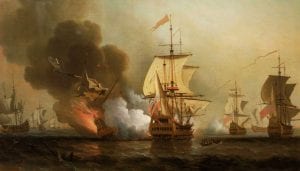- Have any questions?
- +34 951 273 575
- info@allaboutandalucia.com
Sunken Spanish treasures waiting to be found off the coast

Madrid mayor sets out ambitious plan to turn capital into green city
January 27, 2018
Why buying a bike is the only resolution worth investing in for the New Year
January 30, 2018In 2015, the ‘Holy Grail of shipwrecks’ was found off the Columbian coast, carrying loot that could be worth $10 billion.
The Spanish galleon San Jose sank in 1708 during the War of Spanish Succession, taking a cargo of gold, silver, emeralds and jewellery from Spain’s South American colonies to a watery grave.
Colombian President Juan Manuel Santos described it as ‘the most valuable treasure found in the history of humanity’.
Closer to home, the Olive Press reported on a Roman anchor being retrieved from the depths off the Mallorcan coast last December.

WRECKS: Were the subject of one of our articles last issue
Divers from the Guardia Civil’s underwater team also found a pottery jar from 3BC, potentially worth millions, commenting: ‘It is very likely that there are still some gems out there just waiting to be discovered.’
The waters around Gibraltar, famous for wreck-driving, have yielded up countless Roman and Phoenician treasures. Further up the coast off Portugal, the recovery of the Spanish frigate Nuestra Señora de las Mercedes which sank in 1804 sparked an eight-year legal wrangle over ownership which Spain won in 2015.
However much of Spain’s sunken treasure lies under the stretch of ocean between its own shores and its old New World colonies. Many ships in the Spanish Treasure Fleet, a convoy system adopted from 1566 to 1790 to provide galleons with safe passage, fell prey to tempests, warfare and piracy.
The Olive Press set sail to discover the bounty still hidden in the deep.
San Miguel
Before the infamous 1715 Spanish Treasure Fleet sunk off the coast of Cuba trying to escape pirates, an earlier, much heavier bounty entered troubled waters.
Believed to be one of the richest treasure galleons ever lost at sea, the San Miguel was the pride and joy of Spanish conquistadors, carrying a massive amount of Inca and Aztec gold when she sank off the Dominican Republic coast in 1551.

SAN JOSE: One of the most famous lost treasures
The Spanish sent a reconnaissance vessel to retrieve some of the lost gold but salvaged only a small portion.
It was the first blow to Spain’s fleet of valuable ships that would fuel much of Spain’s Golden Age and inspire El Dorado legends for years to come.
Various expeditions have set out to recover the rest of the treasure over the 500 years since the ship sank but nothing has been found
El Salvador
Bound for Cadiz, the merchant ship El Salvador was loaded up with gold, silver and supplies in Havana to join six other vessels heading back to Spain in 1750.
As the convoy set off from present-day Cape Canaveral, Florida, a hurricane forced the ships into the harsh trade winds of the Gulf Stream, pushing them back up the coast to North Carolina.
Smashing into the outer banks, records show the ship foundered on the beach near Ocracoke with a cargo of millions of pesos, four chests of gold coins and 16 chests of silver coins, which still remain buried in the sand.
Nuestra Señora de Atocha
Stacked to the gunnels with gold, copper, silver, gems and indigo from the New World – a cargo so massive it took two months to load it on board – when she sailed into troubled waters in 1622.

CONVOY: Was a tactic to ensure safety in numbers
In what was characteristic of Spanish tactics to ensure the safe passage of its treasure fleet, Atocha sailed in a convoy of 28 ships. But the weather had other plans.
A hurricane hit the convoy with many of the ships sinking off the Florida Keys including the Atocha.
It wasn’t until 1985 and a 16-year search that American treasure hunters Mel Fisher and Finley Ricard discovered almost $500 million of buried loot in the waters off Key West.
Yet experts agree a mother lode is still out there, including precious Muzo emeralds.
Judging from details of the original manifest, there are still 17 tonnes of silver bars on the missing list along with 128,000 coins of different values, 27 kilos of gems and 35 boxes of gold buried in the deep.
Treasure of Lima
One of the most famous lost treasures still attracts hundreds of bounty hunters to this day, although the true story is shrouded in legend.
The haul is said to include two life-sized solid gold statues of the Virgin Mary encrusted in gems, valued at a cool $208 million in today’s money.

LIMA: Setting of one of the most enduring myths about treasure
The known facts are that in 1820, with the capital of Lima teetering on the brink of revolution, the Viceroy of Peru, Jose de la Serna e Hinojosa, decided to get Spanish wealth out of the country for safekeeping, entrusting its transport to Canadian captain William Thompson.
But the temptation of all that glittering booty was too much. Thompson and his cohorts killed all of Hinojosa’s men and fled to Cocos Island, off Puerto Rico, where they buried the treasure.
Later Thompson’s ship, the Mary Dear, was captured by Spanish forces and everyone on board was tried and hanged, except for the Captain and his first mate who were taken back to Cocos, to reveal the treasure’s whereabouts. However, they fled into the jungle and allegedly escaped home to Newfoundland in a whaling ship.
Since then the ‘treasure of Lima’ has been the subject of more than 300 failed expeditions, including one mounted by the American gangster Bugsy Siegel.
The Costa Rican government believes no treasure exists and has outlawed treasure hunting in the area.




